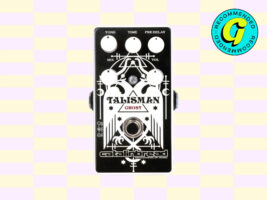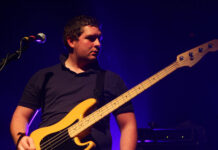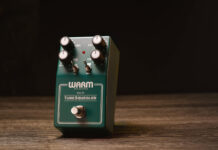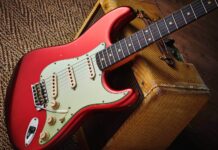
Catalinbread Talisman Ghost review: modulated dual-plate action for ambient bliss
$186.99/£219, catalinbread.com
The original Catalinbread Talisman, a compact recreation of an EMT 140 plate reverb, was released a decade ago – in the distant murky past of 2015. Since then we’ve had our fair share of plate-simulating pedals across the price spectrum, from the more affordable end like the Oceans 11 to the rather pricey UAFX Golden Reverberator, not to mention the wealth of plate algorithms within the nigh-supercomputers that we now call workstation reverb pedals.
READ MORE: Neural DSP Nano Cortex review: NanOS 2.0 update – “Neural’s compact pedal becomes a true all-in-one multi-effects”
Ten years on we now have the Talisman Ghost, a version that – far from adding any complex modern digital features – focuses on making the sound darker and weirder. Could it be the missing piece of your reverb puzzle, or are there missed opportunities here?
In use
Like the original non-ghost (alive?) version of the pedal, here we have a simple mono single-stomp with five knobs. No screens, MIDI or expression control to speak of. The major change is in the algorithm – rather than just a single EMT 140 unit, the TG simulates two of them in parallel, and adds in some pretty severe pitch modulation to apply a thick chorus to the reverb trails.
The fit and finish of the pedal stands out as above-average – the artwork printing is phenomenally crisp, and the footswitch has a very satisfying soft-but-still-clicky feel, and seems to be from the feel a Gorva 3PDT, or at least something very similar.
But, before anything else, let’s talk sounds. It is always a good sign when the first few notes through a pedal elicit a big stupid grin – and that’s exactly what happens when I first strum a chord through the Talisman Ghost. The plate sound is extremely good – plate in general is an awesome sound on guitar for a load of reasons, and here it’s very well-executed. In particular, the pedal doesn’t impart any overt digitalness or artificiality to things.
The predelay, time, mix and volume controls function like you’d expect. Volume lets you keep things balanced, especially in an effects loop, mix goes full wet (which is a lot of fun), time maxes out at almost infinite, and the predelay control gives your dry and wet signals up to 100ms of breathing room, keeping things clearer if you’re doing some busy playing.
Image: Catalinbread
However most of the magic lies in the tone control – rather than the bass/treble balance, this actually adjusts the intensity of the modulation, from a totally unmodulated signal to very wobbly indeed.
What’s perhaps most remarkable is that the pitch modulation remains usable all the way up the sweep. It’s not a subtle effect by any means, but sometimes with pitch modulation, the extreme settings can just sound both inherently goofy and just harmonically nonsensical. As the reverb trails here are such a diffused sound, the pitching adds a much more textural effect, imparting movement and colour – at no point does anything sound like a comedy swanee whistle.
On more subtle modulations with the time almost maxed out, the Talisman Ghost sounds frankly gorgeous. I could easily see it as a do-it-all reverb, for the right player – it’s just such as massive and pretty sound, that does have that very guitar-appropriate frequency response like you’d want from a good plate, no matter how weird you’re wanting to get.
Utility
I do find the Talisman Ghost’s simple approach, for the most part, very good. Personally it being mono doesn’t really bother me, as I’m one of the vast majority of players that doesn’t run a stereo rig. Obviously, the signal-routing potential would be very exciting if it was stereo, but as it stands it’s still an awesome sound once you’ve accepted its mono nature.
The footswitch design is also a little different to what you might see on something from, say, Earthquaker or UAFX – it’s a clicky switch rather than a soft-touch momentary one as is far more common these days. But this is no real bad thing – the pedal still has trails, a bit of tactile feedback is good and, importantly, you can’t actually hear the click in the signal.
But the main reason that the Talisman Ghost is missing out on that final push to a 10/10 is this: the modulated, washed-out shoegazey sounds and the more traditional plate sounds are both excellent – so it would be great to have a performance-friendly way of going between them during a set.
Pedals like Earthquaker’s Ledges and Silos have shown that you can have presets and flexible expression control on a single-stomp pedal at a similar price-point – but on the Talisman Ghost you’re still leaning over and twiddling knobs. Not having presets or even just expression control over the tone knob feels a little bit like a missed opportunity.
Image: Catalinbread
Should I buy a Talisman Ghost?
Overall, the Talisman Ghost is still an absolutely killer reverb unit with a ton of character. The extreme modulation is more than just a silly, overly-modulated ‘weird’ sound – it’s an absolutely stunning texture, one that’s extremely joyful to paint with. It is //relatively// expensive for a single-stomp reverb, however it is also markedly high fidelity when compared to some options out there. If you’re ok with its mono nature and lack of things like presets and expression control, the sounds are worth the price of admission.
Talisman Ghost alternatives
There aren’t really any pedals that do the exact modulated plate thing like the Talisman Ghost does outside of totally customisable reverb workstations, but they’re in a totally different power and price class. For more standard plate sounds, the EQD Ledges ($199/£195) is a perfectly serviceable single-stomp mono reverb, and the UAFX Heavenly is a more restrained version of UAFX’s boutique digital thing in a single-stomp, and at time of writing all of the UAFX single-stomp delays and reverbs are half price ($129/£95), everywhere I can find them!
The post Catalinbread Talisman Ghost review: modulated dual-plate action for ambient bliss appeared first on Guitar.com | All Things Guitar.
Source: www.guitar-bass.net












